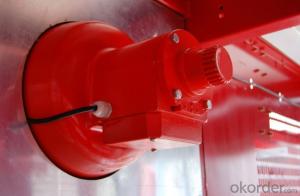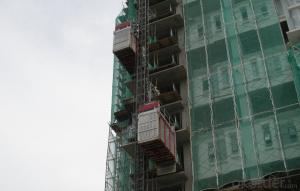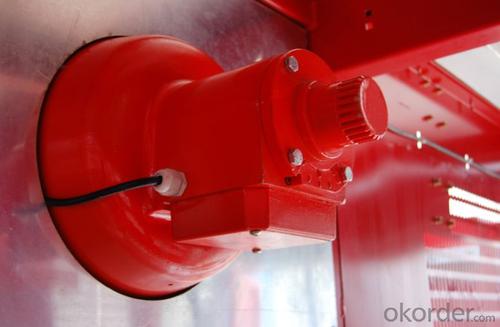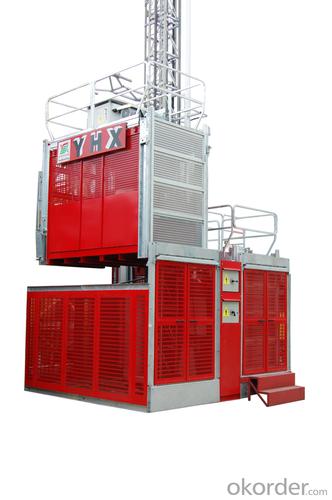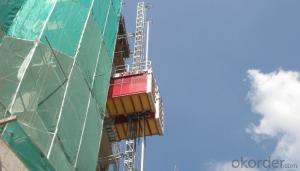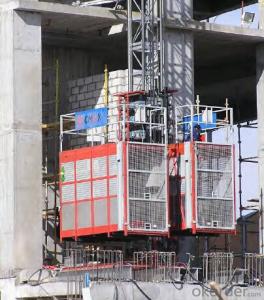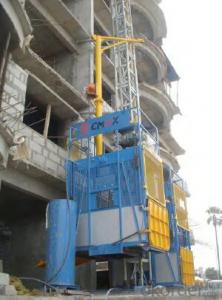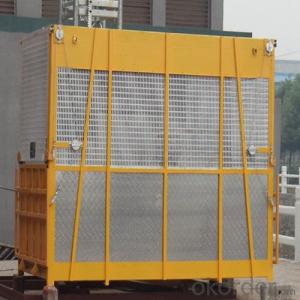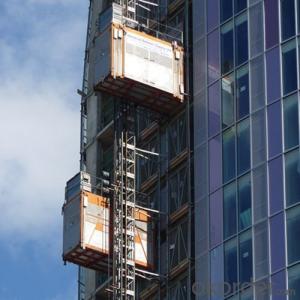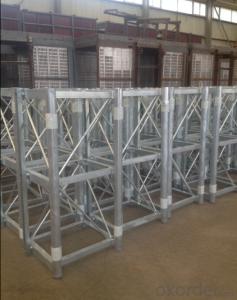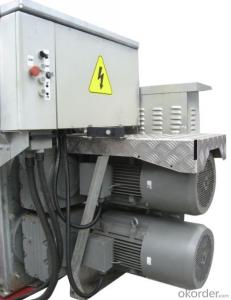YHX Building Hoist
- Loading Port:
- Guangzhou
- Payment Terms:
- TT OR LC
- Min Order Qty:
- -
- Supply Capability:
- 40 unit/month
OKorder Service Pledge
OKorder Financial Service
You Might Also Like
Guangdong Yuhuaxing Construction Machinery Manufacture Co., Ltd., established in March 1997, is a private enterprise specializing in R&D, designing, manufacturing, selling and leasing of construction machinery. Headquartered in Baiyun District of Guangzhou, it is the council unit of Decoration and Aerial Work Machinery Branch of China Engineering Machinery Industry Association and a member of Guangdong Standardization Association, mainly producing builder hoist, mast climbing work platform, superdeck loading platform, temporary suspended platform, building maintenance unit etc.
Taking product sale and leasing as the basic market strategy, the company has effectively built “Yuhuaxing” and provided steady cash flow. On one hand, it pushes the independently developed builder hoist, mast climbing work platform, superdeck loading platform, suspended platform and other standardization products to Germany, Sweden, Australia, Malaysia, Singapore, India, etc.; on the other hand, it energetically expands leasing business of builder hoist, superdeck loading platform, suspended platform and other products. Till now, we have established leasing branches in Guangzhou, Beijing, Shanghai and etc. Besides, according to the different requirements of customers, our company actively develops design, production, sale and other business of building maintenance system, steel aluminum shuttering and other non-standard building machinery and metal parts.
High-quality technological management team and first-rate production and detection equipment lay good foundation for the steady development of the company. Its technology and management personnel, including many senior engineers, have college degree or above, and skilled workers mostly have vocational school degree or above. The company also has over 200 general and special production equipment and over 300 measuring instruments for detection. The company passed the certification of ISO9001 Quality Management System in 2002, providing reliable guarantee for the management system and product quality.
Our Yuhuaxing concern requirements of modern city construction and strive to provide products with advanced technology and rational price, furnish good technical support and pre and after-sales service for customers. We hope to create beautiful future with customers.
【Corporate Vision】
Vision:Become an ever-green construction machinery enterprise and maximally meet customers’ requirements
【Core Values】
Quality: High quality, innovation, safety and reliability.
High quality is the basis of the enterprise.
Innovation is the soul of the enterprise.
Safety is reverence to life.
Reliability wins the trust.
Service: Customer focused, customers are existence value of Yuhuaxing people, do what we have promised.
Responsibility: Attentive and responsible, brave to undertake and fully perform individual, company and social responsibility.
【Spirit】
Hard Work:Industry, simplicity, perseverance and hardships are the source power of Yuhuaxing to achieve transnormal and leapfrog development.
Struggle:Concentrated reflection of brave advance, assiduous seeking, brave challenge and enthusiasm and progress of Yuhuaxing people.
Pioneering & Progress::Promote traditions, keep pace with the times, have the courage to innovate and pursue excellence in work
- Q: This question asks for a comparison of the pros and cons of utilizing hydraulic cylinders in the context of building hoists.
- <p>Hydraulic cylinders in building hoists offer several advantages, including high force output, compact size, and precise control. They provide smooth and controlled lifting, which is crucial for heavy construction materials. Additionally, hydraulic systems can generate large amounts of force with relatively small cylinders, making them space-efficient. The disadvantages include potential leaks, which can be hazardous, and the need for regular maintenance to ensure the system's reliability. Hydraulic systems can also be more complex to install and repair compared to electric or manual systems. Furthermore, they require a constant power source, which might not always be readily available on construction sites.</p>
- Q: What is the function or use of constructing a building hoist?
- <p>The purpose of building hoists is to facilitate the vertical transportation of materials, equipment, and sometimes personnel during the construction process. They are essential for moving heavy items to various floors or levels of a building under construction. Hoists enhance efficiency, reduce manual labor, and improve safety by minimizing the risk of accidents associated with manual handling of heavy loads. They are particularly crucial in high-rise construction where access is limited and the volume of materials to be moved is substantial.</p>
- Q: Explain the differences between electric and electric-motor-driven building hoists in a few sentences.
- <p>Electric hoists are powered directly by electricity and use electric motors to lift and lower loads. They are typically smaller and more portable, suitable for lighter loads and indoor use. Electric-motor-driven hoists, on the other hand, use an electric motor to power a separate mechanism, often a winch or pulley system, to move loads. These are generally more robust, capable of handling heavier loads, and are often used in construction and industrial settings. The main differences lie in their power transmission methods, load capacity, and the environments in which they are used.</p>
- Q: This question asks for guidance on the upkeep and repair procedures for a building hoist, a mechanical device used for lifting materials in construction.
- <p>To maintain and repair a building hoist, follow these steps: Ensure regular inspections by qualified personnel, checking for wear and tear, and addressing any issues promptly. Lubricate moving parts as per the manufacturer's guidelines to reduce friction and prolong component life. Replace worn-out cables, pulleys, and other critical components to prevent accidents. Keep the hoist clean and free from debris to prevent jams and malfunctions. For repairs, always consult the manufacturer's manual or hire professional technicians to avoid safety hazards. Regular maintenance and prompt repair are crucial for the safe operation of building hoists.</p>
- Q: Can a building hoist be utilized for lifting objects that exceed manual lifting capabilities?
- <p>Yes, building hoists are specifically designed to lift and transport objects that are too large or heavy for manual lifting. They are commonly used in construction to move materials and equipment to various levels of a building. Building hoists are equipped with safety features and can handle substantial weight, making them an essential tool in construction projects where heavy objects need to be moved efficiently and safely.</p>
- Q: What is the main function of elevator motherboard?
- The elevator motherboard is different from each brand, and it functions like a computer motherboard
- Q: This question asks whether a double-rope lifting system can be safely and effectively used in both indoor and outdoor environments, specifically during windy conditions.
- <p>A double-rope lifting system can be used both indoors and outdoors, but its use in windy conditions requires careful consideration. Indoors, it is generally safe and effective. Outdoors, windy conditions can pose challenges. High winds may cause the load to sway, potentially leading to accidents. Therefore, it's crucial to adhere to safety guidelines, which often recommend not using such systems in winds exceeding certain speeds, typically around 20-30 mph. Always check the manufacturer's specifications and local regulations for safe operating conditions.</p>
- Q: Identify the elements that influence the durability and operational lifespan of lifting machinery, specifically focusing on Building Hoists.
- <p>The lifespan of lifting equipment, including Building Hoists, is influenced by several factors: 1) Material Quality: The type and quality of materials used in construction directly affect durability and resistance to wear and tear. 2) Design and Engineering: Proper design ensures optimal performance and reduces stress on components. 3) Frequency of Use: More frequent use can lead to faster wear and tear. 4) Maintenance and Repair: Regular maintenance can extend the lifespan, while neglect can shorten it. 5) Operating Conditions: Environmental factors such as temperature, humidity, and exposure to corrosive substances can impact longevity. 6) Load Capacity: Overloading can cause premature failure. 7) Compliance with Safety Standards: Adhering to safety guidelines can prevent accidents and damage. 8) Technological Advancements: Newer models may have improved features that extend lifespan.</p>
- Q: This question asks about the various mechanisms that enable lifting in building hoists, which are essential for construction projects.
- <p>Building hoists utilize several types of lifting mechanisms to efficiently move materials and personnel. The most common types include: 1. Geared Hoists, which use a system of gears to lift and lower loads. 2. Electric Chain Hoists, powered by electric motors and are suitable for heavier loads. 3. Air Hoists, which use compressed air to generate lifting force and are ideal for environments where electricity is a hazard. 4. Manual Chain Hoists, operated by hand and best for lighter loads. 5. Electric Wire Rope Hoists, which offer high lifting capacities and are controlled by electric motors. 6. Pneumatic Hoists, similar to air hoists but use pneumatic power for lifting. Each type has specific applications and safety considerations, making them suitable for different construction needs.</p>
- Q: Is it possible to utilize a building hoist for the purpose of raising construction materials or machinery?
- <p>Yes, a building hoist is specifically designed for lifting materials and equipment in construction settings. It is a temporary vertical transportation system used to move materials, tools, and sometimes personnel between different floors of a building under construction. Building hoists are essential for efficient construction processes, ensuring that materials are delivered to the correct levels without the need for manual labor, which can be time-consuming and hazardous.</p>
Send your message to us
YHX Building Hoist
- Loading Port:
- Guangzhou
- Payment Terms:
- TT OR LC
- Min Order Qty:
- -
- Supply Capability:
- 40 unit/month
OKorder Service Pledge
OKorder Financial Service
Similar products
Hot products
Hot Searches
Related keywords
